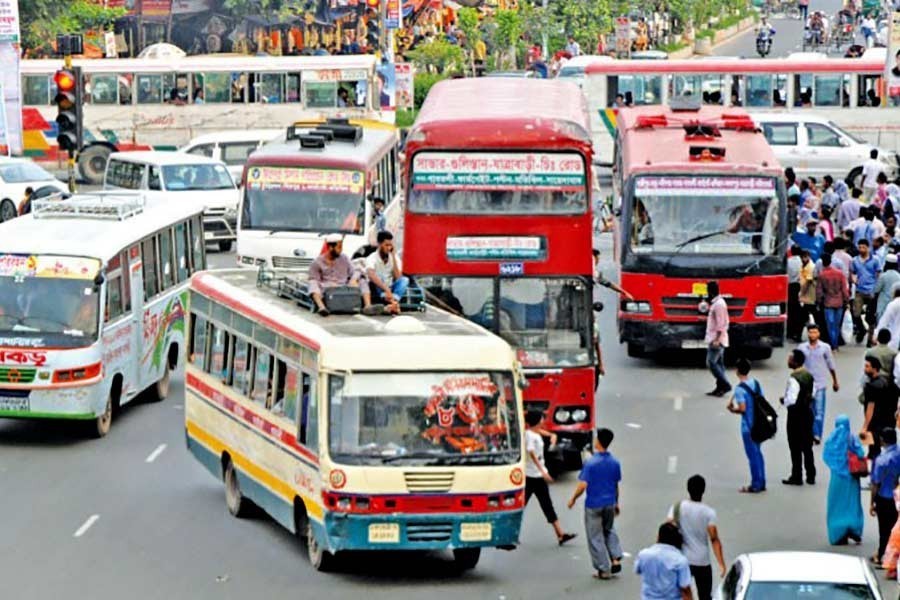
Published :
Updated :

The much trumpeted transport law has met its inevitable fate -- not so much because of the enforcers' neglect but the unworkable circumstances that make enforcement of many key provisions of the law difficult, even impossible. Soon after the draft law was formulated, experts did mention that unless the country's unruly transport sector is sufficiently reformed, the law will not be able to take its own course. The media, too, took note of the issue flagging reform as a prerequisite for the law to be effectively implemented.
Clearly, the authorities did not pay heed to the concerns expressed, or if at all did, considered the law no different from scores of other laws that remain mostly shelved or are applied only rarely. Given that a transport law is not just a set of pious intentions, but one meant to be enforced, even stringently, it has no scope for leniency for the sake of the safety of millions of people on roads and highways across the country.
The prevailing situation has brought to the fore some critical issues that should have been resolved well before the law coming into force. The law forbids plying of many indigenous transports such as covered vans, legunas, nosimons, karimons etc., but no prior action was taken to ban those outright. Similarly, there was no firm action to remove unfit transports from the roads nor was there any noticeable drive to ensure that drivers, especially of heavy vehicles, have appropriate driving licences. The provision in the law for stern penal action against illegal vehicle parking -- an issue that has sparked the most discontent -- appears to be unjustifiable in the country's prevailing context, as there are very few legal parking spots in the country, even for the buses and trucks. For the private vehicles, except for some shopping malls in Dhaka and Chottogram, there is hardly any dedicated parking space. The demand for parking facilities, particularly in the capital, is a longstanding one, but no effort has been in sight to create the facilities by the government or incentivise the private sector to build such facilities. So, in the absence of legal parking facilities, imposing hefty fines for roadside parking of vehicles is totally unfair. Again, the method of investigation into road crashes, as envisaged in the law, appears to have largely ignored the point of view of the alleged offenders -- the drivers.
As the scenario has ceased to change, it is clearly the sense of sanity to discipline the chaos that has become a casualty. Observers, however, still believe that with required reforms gradually in place, the law can be implemented by phases. And to do so, there is a lot to think about and work on. There is also the need to revisit some of the provisions of the law to render those more realistic and workable.
In this context, it is pertinent to mention that the promised Rules for the Highways Act 2021 are yet to be framed two years after the enactment of the law. The Roads and Highways Department (RHD), under the road transport and bridges ministry, has reportedly drafted the rules for the law. The draft proposes detailed classifications of the highways, plans for the networking of the highways, maintenance and operation, database and updating designs and standards.
Replacing the Highways Act 1925, the government issued a circular on December 7, 2021 following which the Highways Act 2021 came into effect. The law has a total of 19 sections, allowing the RHD to run specific vehicles on specific highways, plans for maintenance, operation and design of different highways, while also providing for punishment for different offences. The draft rules, meanwhile, have a total of 28 sections. It gives detailed definition of three types of highways -- regional, district and a new one -- border highways and says that the expressways, national, regional, district and border highways under the RHD will be under the purview of the rules. As per the RHD's report, the department has a network of 22,476 kilometres of roads and highways including 3,990 kilometres of national highways, 4,897 kilometres of regional highways and 13,587 kilometres of district roads.
Highways are veritable death traps fraught with risks of road crashes. So far, stray efforts to bring some semblance of discipline, even in restricting slow moving, ramshackle indigenous vehicle from plying the highways have failed. If the rules are finalised soon enough, it is the enforcement issue that remains the major concern.
Strange though it seems rules meant to regulate and discipline any particular arena of social or economic activities have hardly been successful in this country, to say the least, and if at all, the exercises in most cases are an eye wash. When it comes to issues like road safety, it appears to be no different. The intent to improve the state of chaos, however sincere it may be, must not remain confined to well-meaning laws and manuals only. The authorities know it well enough. To bring about a real change in the transport sector, the ground has to be prepared painstakingly first.
wasiahmed.bd@gmail.com


 For all latest news, follow The Financial Express Google News channel.
For all latest news, follow The Financial Express Google News channel.